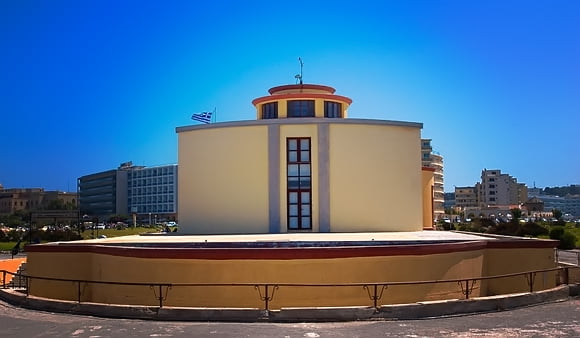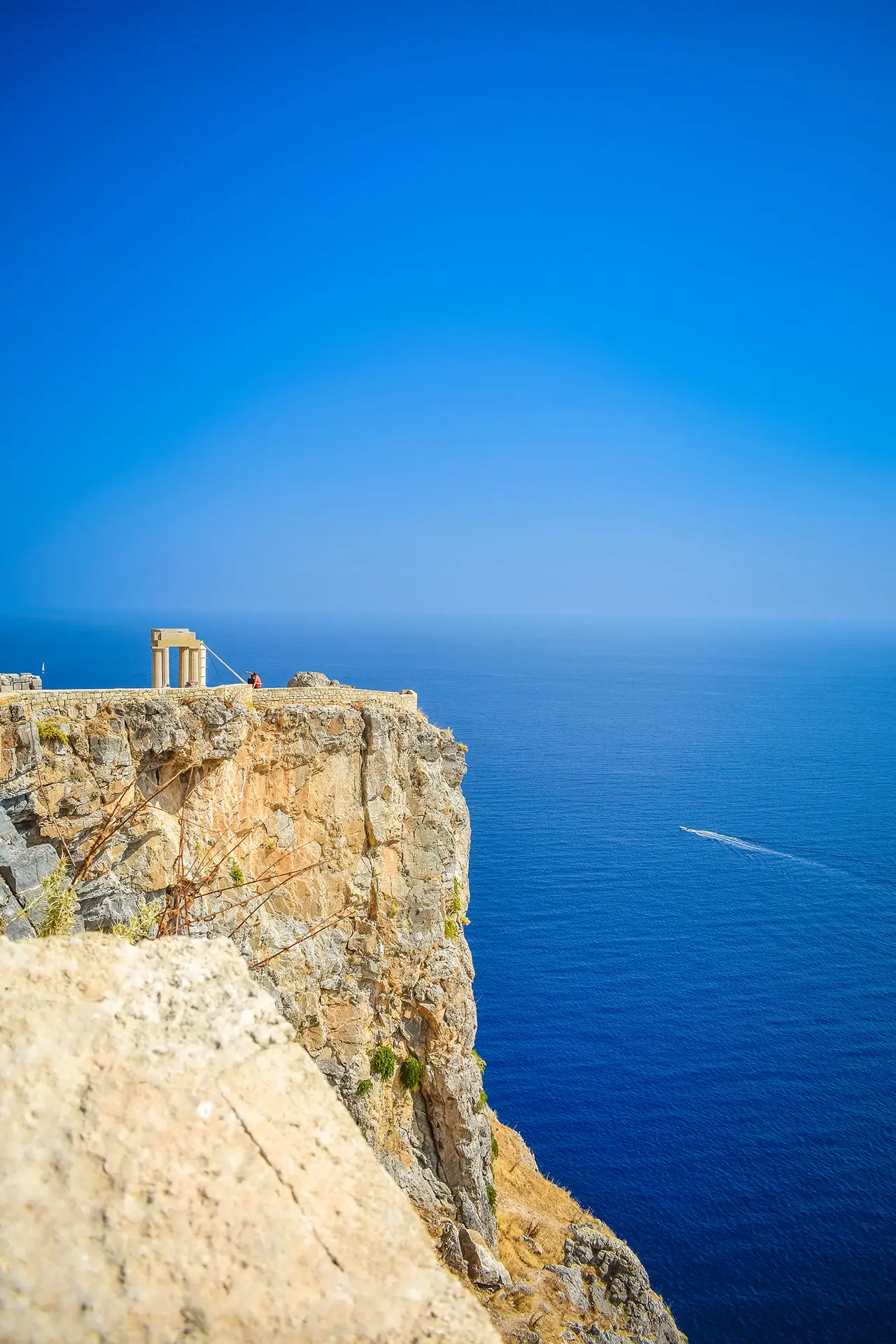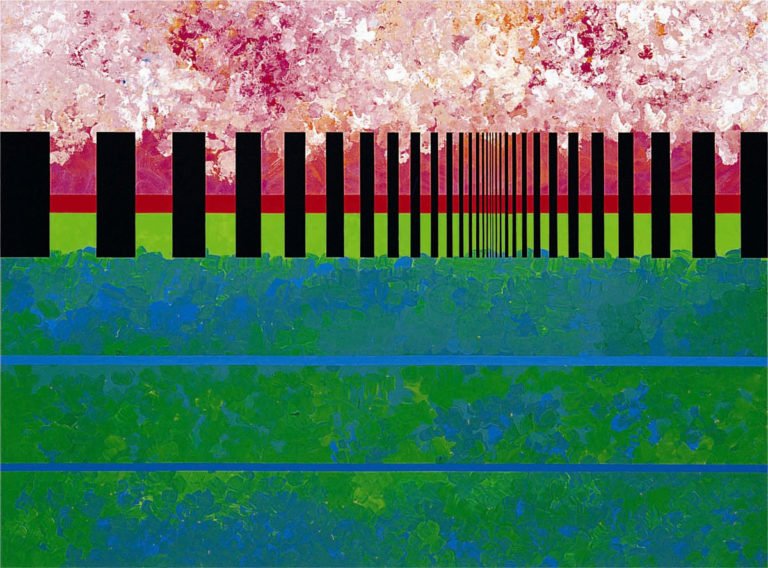
Rhodes Aquarium

In 1934, during the Italian occupation of the Dodecanese Islands (1912-1943), the Governor Mario Lago launched the construction of the Reale Istituto di Ricerche Biologiche di Rodi (Royal Biological Research Institute of Rhodes) in Cape of Mili, the northernmost point of Rhodes Island.
The Italian architect Armando Bernabiti undertook the projects of designing and building, the latter finishing in 1935. In his work, local and Art Deco architectural elements were combined with others of naval aesthetics, such as curved lines, openings like portholes, various raising levels and a central cylindrical tower. The marine fauna inspired the main entrance decoration. Aquarium’s original interior, decorated with porous rocks and natural seashells, brings to mind an underwater cave and has not changed over the time. Unaltered has also remained the floor, paved with a black and white pebbles mosaic, on which marine creatures are represented.
The original exterior of the building did not change until 1971-72, when an exhibition hall (museum) and a pool for seals were added at the north side.
The Institute began to operate in 1937 focusing mostly on biological and hydrological subjects related to the Aegean Sea and also on problems regarding sponge fishing, fisheries and agricultural entomology, hosting at the same time an aquarium with interesting samples of the Mediterranean fauna.
From 1948, when Dodecanese Islands were united with Greece, until 1963 the Institute continued operating as a Regional Station of the Hellenic Hydrobiological Institute under Athens Academy of Sciences auspices. Since 1963, with its present name, the Hydrobiological Station of Rhodes (H.S.R.) operates as Aquarium and Museum and research unit of the Hellenic Center for Marine Research (H.C.M.R.-Ministry of Development/General Secretariat of Research and Technology) (www.ncmr.gr, www.euac.org, www.eaza.net ).
The Greek Ministry of Culture has characterized H.S.R’s building as an historical landmark and distinguished sample of the “International” architectural style.The aim of the Hydrobiological Station of Rhodes is “To develop and propagate scientific knowledge on the marine environment and its conservation”.
Some of its activities:
- Oceanographic research in the Aegean and Mediterranean Seas.
- Development of know-how in the field of aquariology.
- Study and conservation of endangered aquatic species.
- Rescue – treatment – rehabilitation – release of aquatic animals in distress.
- Cooperation with other research and educational institutes.
- Providing of training and consulting for a sustainable management of the marine environment Training of students on specialized subjects.
- Educational activities aiming at awaking environmental conscience of secondary education pupils.
- Transfer of knowledge concerning the seas to specific public groups by organizing specialized lectures and seminars.
Interesting fauna and flora species, endemic to the Aegean and the Eastern Mediterranean Seas are mainly exhibited in the Aquarium, along with immigrant species coming from the Red Sea. In the Aquarium’s part that is devoted to marine life there are 12 tanks, from 1.000 to 5.000 liters capacity, a 25.000 liters central circular tank and 15 small aquaria of 50-100 liters capacity each. In the Museum a 1.000 liters aquarium hosts the endangered freshwater fish Gizani (Ladigesocypris ghigii), endemic to Rhodes Island (www.life-gizani.gr).
Managing Aquarium’s hosted species (collection, transport, nutrition, care and display) and monitoring and maintaining the facilities demand daily and elaborate work of a team comprising biologists, ichthyologists and technicians. Special care is devoted to the preparation and distribution of food to the aquarium-hosted specimens. Their diet includes squids, mussels, shrimps, octopuses, fishes and fresh vegetables.
An open seawater circulation system is installed, i.e. the water is continuously renovated, with a minimum treatment, ensuring almost natural living conditions for the hosted specimens. The seawater, pumped at 44m, is filtered through pro-filters and sand-filters and successively is distributed to the tanks. A volume of about 75.000 liters of seawater circulates in the Aquarium’s installations, the curatorial tanks included. The seawater temperature in the tanks is 16,5-17° C in winter and 19-22° C in summer. The pH ranges from 7,90 to 8,60, the salinity is about 39‰, the dissolved oxygen 6,70-8,80 mg/l and the turbidity is nearly zero. Telematics are used for monitoring the aquarium’s technical installations and the seawater quality.
A closed system is used for the 3.500 liters of fresh water circulating in the exhibition and laboratory tanks. The fresh water undergoes an ultraviolet treatment and is recycled through mechanical and biological filters, while its physical-chemical parameters are daily monitored.
Museum’s interesting collection comprises rare exhibits that are accompanied with informative material and video-projections.
Opening hours
The Aquarium is open daily at following hours:
From April 1 – October 1 at 09.00 – 20.30
From November 1 – March 31 at 09.00 – 16.30
Closed on Greek Orthodox Easter Sunday, Christmas Day (December 25) and New Year’s Day (January 1).


